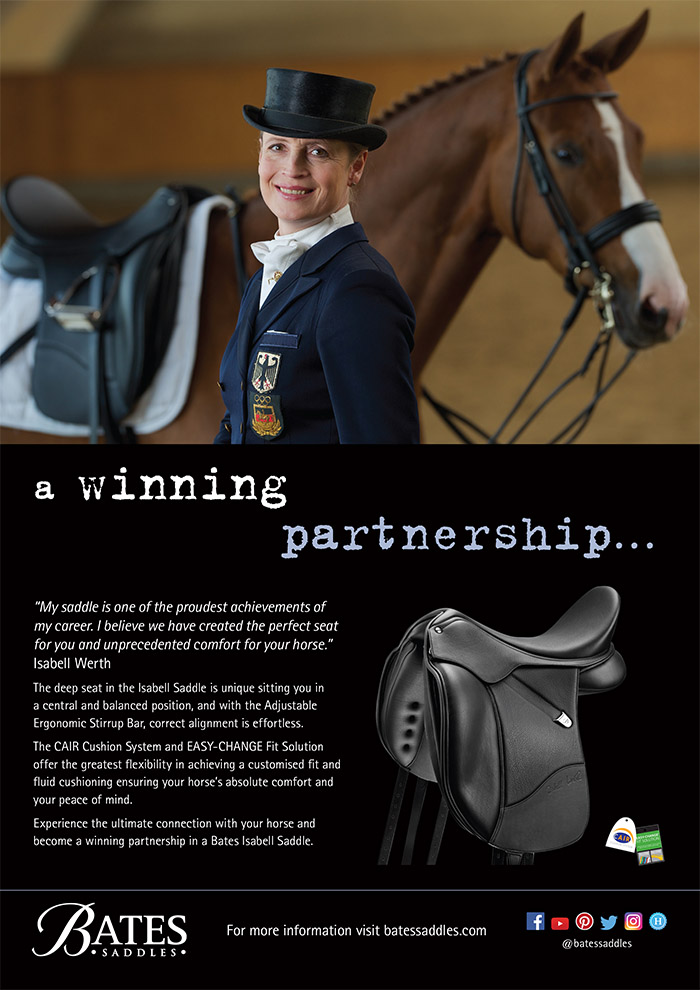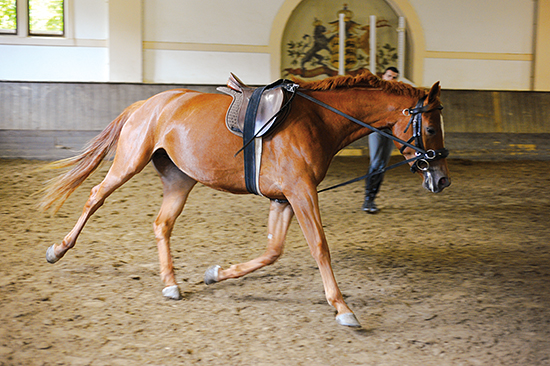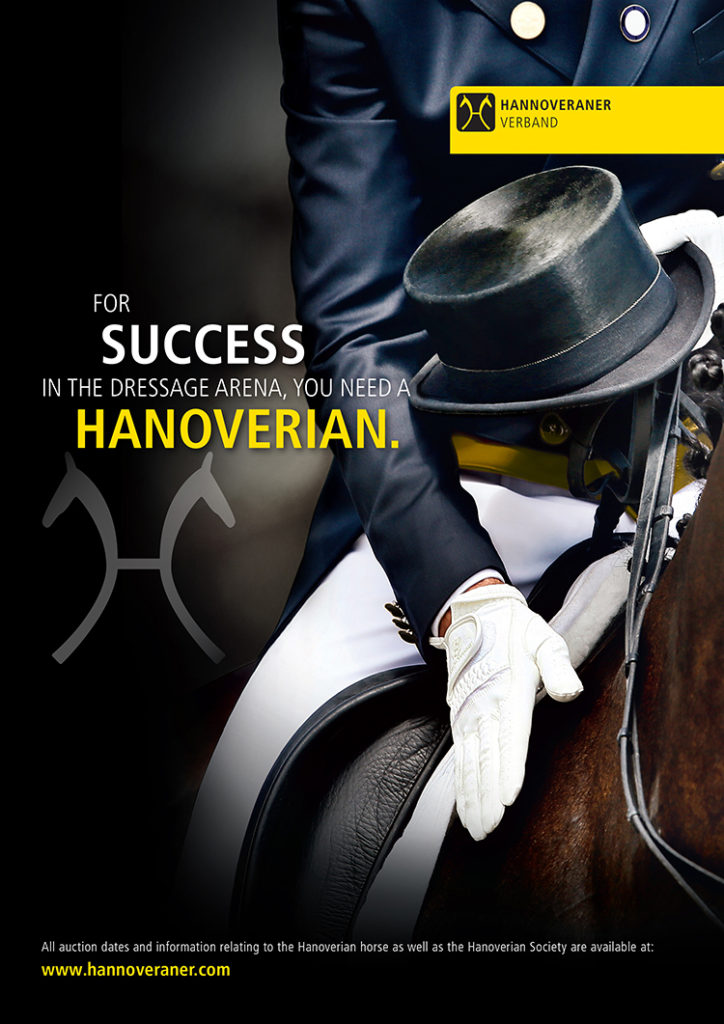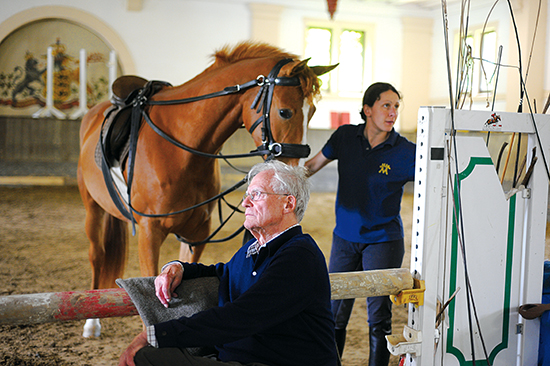 Story by Chris Hector & Photos by Roz Neave
Story by Chris Hector & Photos by Roz Neave
We are saddened to learn of the recent death of Fritz Stahlecker. He was a thinker, a horseman, and someone who was prepared to put his theories into action and show how they worked. The world is poorer for his passing, richer for his thinking…
I remember talking to Sven Rothenberger when he suddenly re-appeared on the world dressage stage in the early 1990’s. He told me that his Grand Prix stallion Weyden, the horse that was to carry him to an individual bronze at the Atlanta Games, had been trained almost entirely in hand by a retired businessman. The businessman’s daughter had ridden the horse successfully in local shows, but because of family commitments was unable to compete him internationally – so he was sold. Sven said that when the horse was delivered he came with a book-length set of operating instructions, right from how the horse should be tied in the box, to the movements of the Grand Prix.
I’d more or less forgotten that conversation until I chanced upon the now 83 year old Fritz Stahlecker working with some young horses in an innovative project underway at the Marbach Stud in the south of Germany. Mr Stahlecker had been ‘given’ six young horses to work, with two of the resident riders, Rudi Schmelcher and René Mau. The idea was that the horses would be prepared for the Stud’s Annual auction, then the prices they fetched would be some sort of objective measure of whether the training process ‘worked’.
Mr Stahlecker is one of those inspirational figures who if you are very lucky you get to meet a couple of times in a lifetime, and the work he demonstrated with the young horses was truly beautiful…
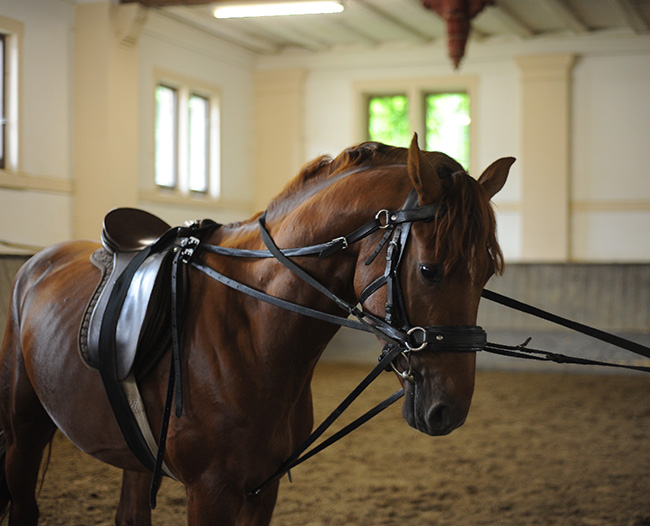
Mr Stahlecker has developed his own gear over the years. A padded cavesson (it’s very padded and soft, and the latest version softer still) with a side rein and an over check rein that connect to the nose piece. The bit in the horse’s mouth is not attached to anything. The trainer works with long rein attached on both sides to the cavesson…
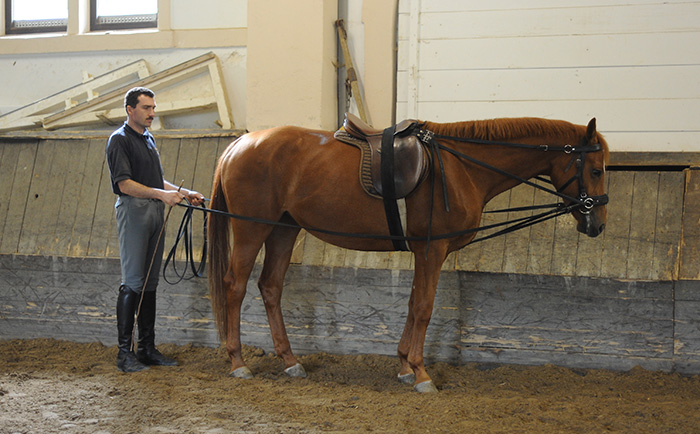
It didn’t hurt that one of the first group of two, a three year old stallion, by Weltpoet, is a truly stunning horse with what appears to be an exceptional temperament. The other was a more difficult character, a bay who had kept bucking his riders off in the training last year, and who was in the project as a challenge to Mr Stahlecker’s methods.
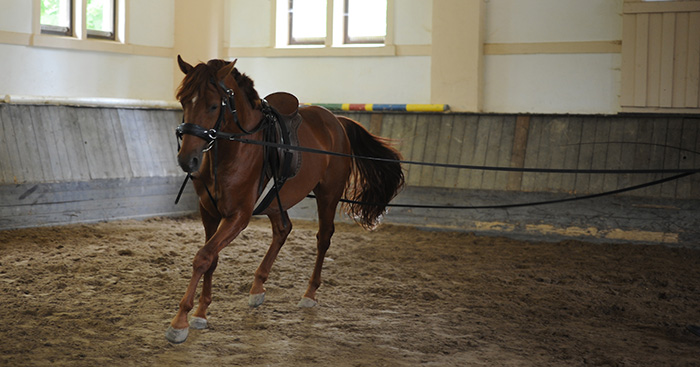
The young man has the chestnut stallion at quite an extreme angle to the wall and he starts making some elevated shorter steps, ‘that’s what we want,’ Mr Stahlecker explains. “I have been working six months with this chestnut, and he is learning all the lessons he will need.
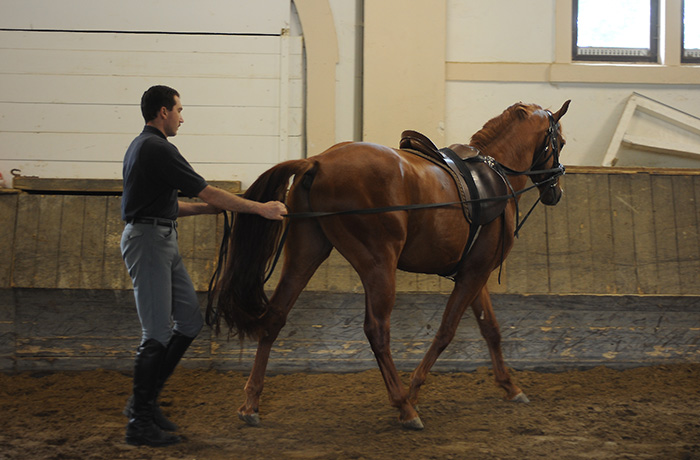
We start with travers, but travers without flexion – flexion we will add later, we must work calmly, step by step.”
next Mr Stahlecker emphasises calmness
Calm is the key to progress: “When their heart is going quick, they can’t learn. When they are calm, they learn. The important thing is that there is no stress. We teach them all the movements, when they have learnt piaffe, then we can start to ride them…”
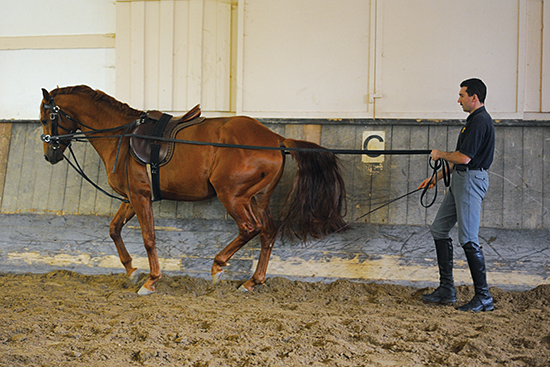 The horse is showing the Spanish Walk – another gymnastic for its future career, ‘this way we increase the mobility of the shoulders’, and he is into some more wonderful short steps, but the truly amazing thing is that when he finishes the advancing piaffe steps on the first side, Rudi turns him around to walk him back to start again, and the horse is totally relaxed, not stirred up at all by this work in extreme collection, and the walk is big, relaxed and absolutely true.
The horse is showing the Spanish Walk – another gymnastic for its future career, ‘this way we increase the mobility of the shoulders’, and he is into some more wonderful short steps, but the truly amazing thing is that when he finishes the advancing piaffe steps on the first side, Rudi turns him around to walk him back to start again, and the horse is totally relaxed, not stirred up at all by this work in extreme collection, and the walk is big, relaxed and absolutely true.
“This is a very good horse,” Mr Stahlecker beams, “I think this horse could be good for the Olympic Games. He is a three year old, and this is very easy for him – and we use no force at all. The piaffe is a preparing exercise – to prepare levade or passage, it is a gymnastic exercise for the horse – an exercise to develop the muscles.”
more follows
Can every horse learn to piaffe?
There is a long pause before the answer: “Yes, more or less. Very small steps of piaffe are possible for every horse.”
The stallion is then worked in canter on a ten metre circle, again it is a wonderful gymnastic exercise, the youngster is really learning to use his inside hind leg, and to find his own balance, you can imagine what joy it would be to be the lucky rider who gets to sit on him for the first time.
“We should not ride the horse before it is four years old, but this way we do not waste time. We can still strengthen them and prepare them. We can teach every exercise with less difficulty than when they are under saddle. The horse must know every exercise before we get into the saddle for the first time.”
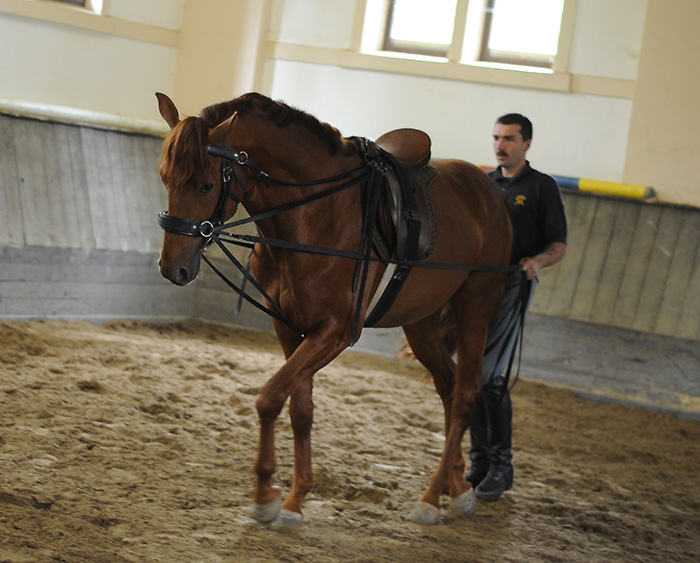
“I have developed this method step by step over the last 30 years and horses trained in this manner have been very successful.”
But where did you learn this method?
“It is my wish to be an artist. In my profession, I am an engineer, but I was still interested in painting and in horses. I observed the training methods and felt they were too old, too robust. To train a horse by force is not an art. For me, to ride is an art like music or painting. Dressage is not a sport. When you play the piano it is not a sport or work, it is playing. We are not working our horses, we are playing our horses.”
more follows
I remark that it is amazing that the trainers work so close to the horse’s hind legs. “It is important that the trainer be very close to the horse…” Right now, close enough to be patting its rump. Do they never kick? “It is a question of confidence.”
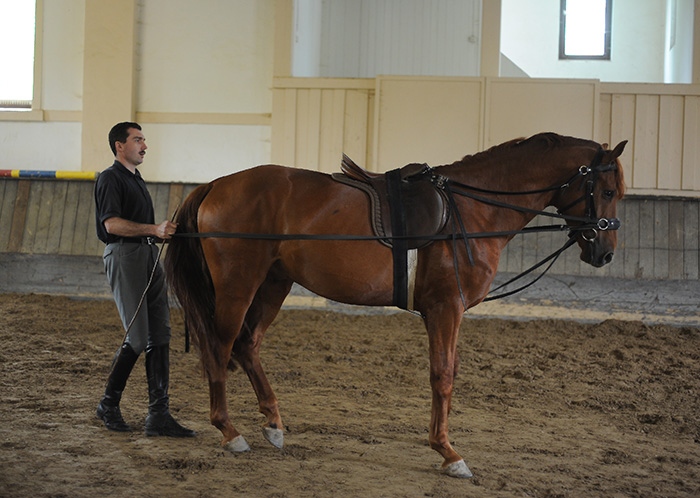
Fritz Stahlecker found his inspiration in the French School. “The French are the real inventors of dressage. Anyone can dominate a horse with force, without force it is much more difficult to train the horse, but you can do it, with confidence. The horse must be confident, and that is why we work in lots of small steps.”
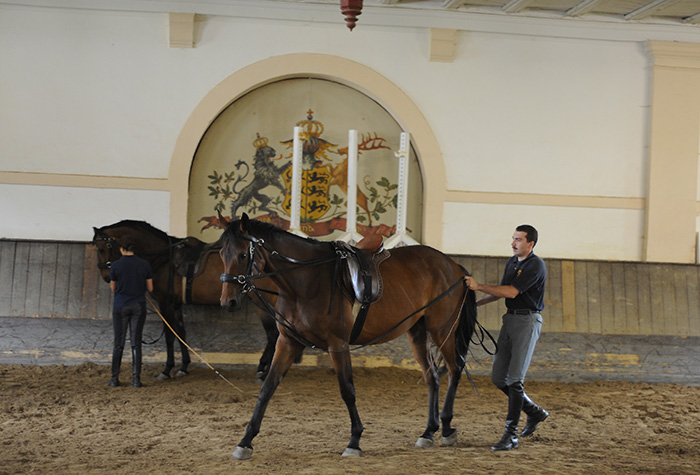
The first lesson is to teach them to halt:
“We must teach them to stand first of all. The horse is willing to do what you want, if he understands what you want. Step by step show the horse what we want, and never ask for two things at the same time. Travers for example, is first the movement of legs, and second the element of flexion. First ask for crossing of the legs but no flexion, later we can ask for flexion. I divide all the Classical exercises into little steps. They work in the travers, then we make a curve and they come around – we have a pirouette. We combine all these steps, but in a way the horse can understand.”
“When the horse comes out of the stable, I ask these things in walk, walk is the movement for learning. If the horse becomes fast, then their instinct becomes stronger and it is harder for them to learn.”
At this stage both Roz and I are a little amazed. As readers of this magazine know, we have done a lot of work with Australian trainer, Andrew McLean, and Fritz Stahlecker’s ideas are just so similar to Andrew’s…
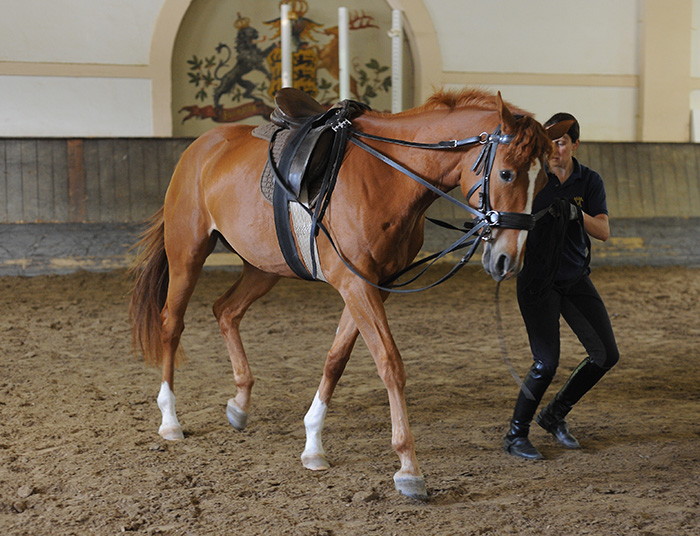
“Of course at times we have to dominate the horse, but in a manner of friendship. Horses like to learn, they are proud to repeat and show, it is just when teaching new things we must be very prudent, we must progress slowly.”
The work finishes after twenty minutes, and again, this is part of Mr Stahlecker’s method. “Never more than twenty minutes. You can work them two or three times a day, but never for more than twenty minutes, they cannot concentrate for any longer. My method might be more expensive than some other ways of training, but a trainer could work 12 horses in a day because we work them such a short time.”
Two more three year olds are in the school. A bay mare by Lancier out of a Bolero mare, and a brown gelding by Worldly out of a Lenny’s Lemon mare.
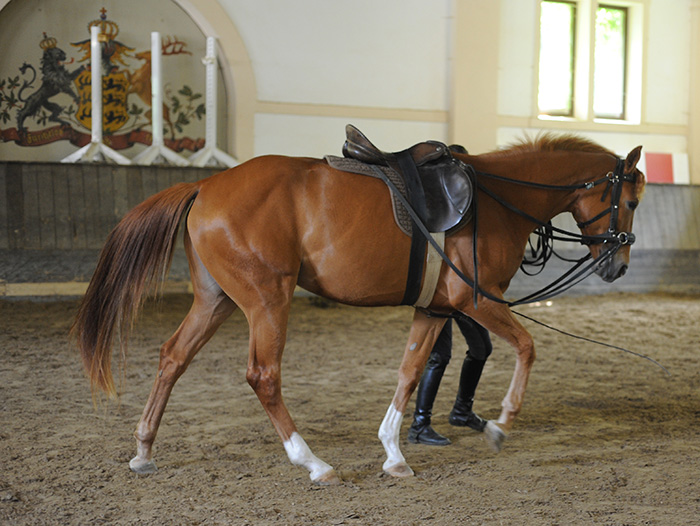
Mr Stahlecker likes to see the trainers working with their whips very close to the horses. “The whip is very near the leg, that way they can touch the horse with a very short movement. They can use the stick to say ‘good’. It was difficult in the beginning for the trainers working with me. It was all new to them and in the first few weeks, they did not see any result. Now they can see.”
“My method is based on a totally different philosophy. The horse and the rider have different lives, but both lives have the same value. This is a revolutionary thing to say but my thinking is based on the thought of Albert Schweitzer, two lives but the same value, that influences the way we treat a horse.”
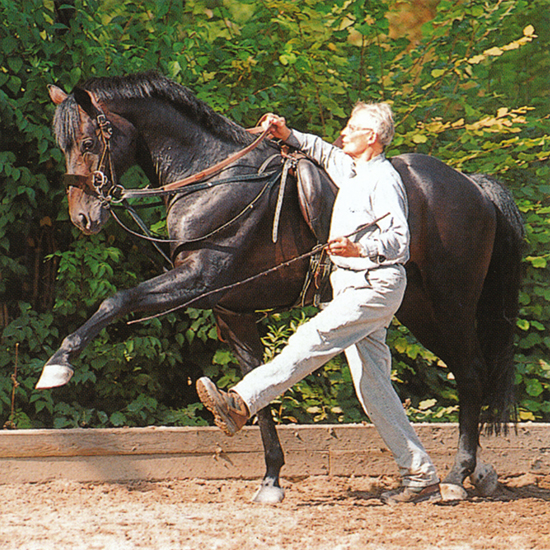 When do you connect the bit?
When do you connect the bit?
“In a few weeks we will start to use the bit a little. They must learn the language of the bit in the work in hand, not from the saddle.”
Once again the work has been of a very high standard, these horses should be just so great to ride. The next two are mares. One by Weltino, was something of a problem: “In the first few weeks she would strike, now there is no danger, but in the first weeks, you had to be prudent.” The other is by Epicure, and “she will become a great dressage horse.”
“We work the horses only 20 minutes, for the rest of the day, the horses can stretch and relax. When the rider is in the saddle, it is important that the horse can go long and stretch, but here in hand, most of the time we are teaching them not to use their neck to balance. You can see it in nature, if the horse gets excited he can hold his neck very still, he does not need it for balance. For the horse to work with the rider, he must be in a certain shape and balance, with this work we bring them to that stage.”
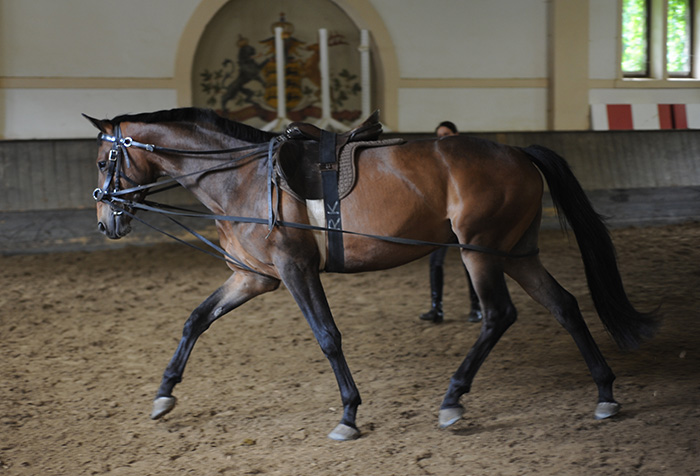
René has her mare working on the small circle in the lunge: “Now she is starting to ask for flexion, and the mare gives a little but she does not like it. Flexion is not near to the horse’s nature, if you ask for something that is not normal for the horse, do it slowly.
And when Rudi’s horse looks as if he wants to stretch more, Mr Stahlecker loosens the over check. “But you should not let the horse stretch too much with the rider on top because it overloads the front legs. The way to give strength to the horse’s back is not stretching in front, the strength in the back comes from behind. The aim is that the rider is capable of putting the neck in any shape we want…”
And Rolkur?
“The most important judgement is the aesthetic judgement. It is simple: what looks bad, is bad. Rolkur looks terrible, and it is terrible. What looks good, is good.”
Certainly this has been the case in this little working session. The horses all seem to benefit so much from this thoughtful preparation.
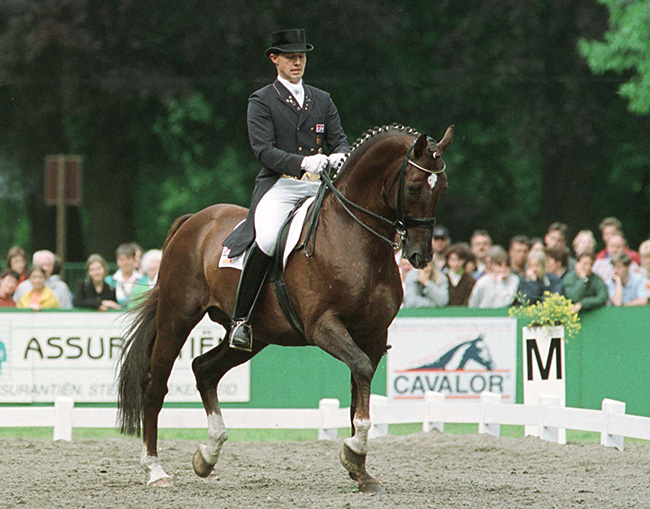
Sven Rothenberger and Weyden, trained by Mr Stahlecker and a medal winner for both Sven and Gonellien Rothenberger.
Want to find the stallion to suit your mare? Go to www.ihb.com.au
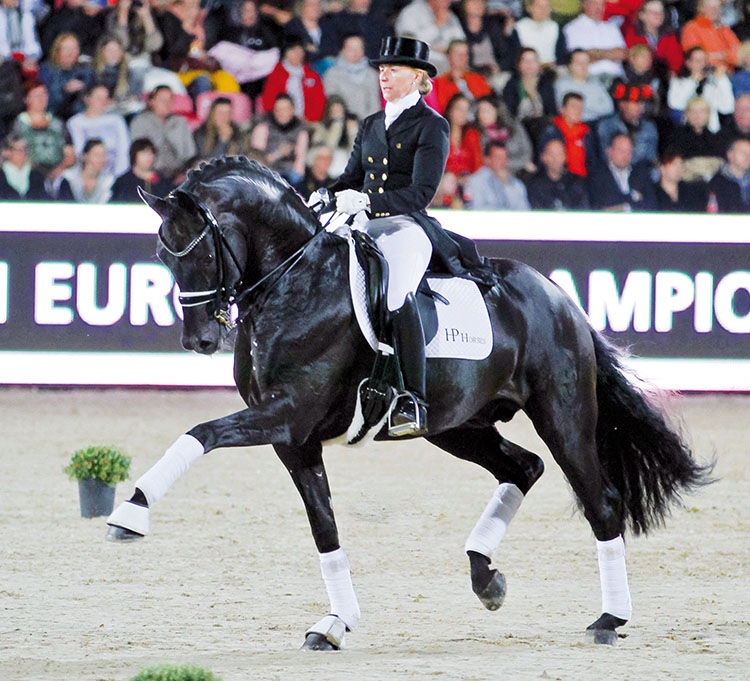
How about Fürstenball?




